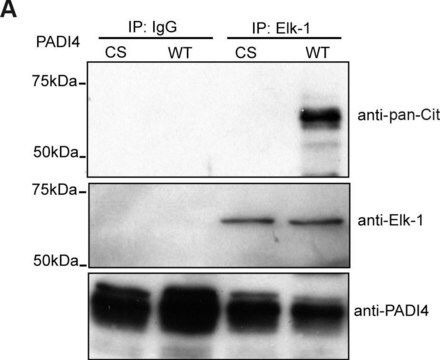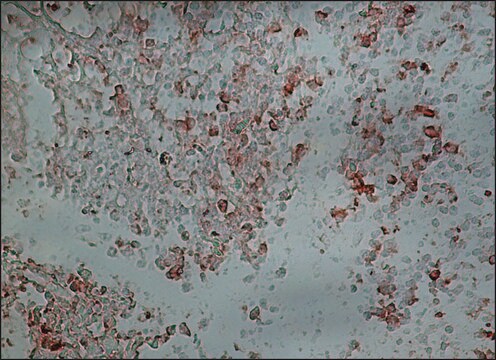12-342
Rabbit Anti-Sheep IgG Antibody, HRP conjugate
Upstate®, from rabbit
Sign Into View Organizational & Contract Pricing
All Photos(1)
About This Item
UNSPSC Code:
12352203
eCl@ss:
32160702
NACRES:
NA.46
Recommended Products
biological source
rabbit
Quality Level
conjugate
peroxidase conjugate
antibody form
affinity purified immunoglobulin
antibody product type
secondary antibodies
clone
polyclonal
species reactivity
sheep
manufacturer/tradename
Upstate®
technique(s)
ELISA: suitable
immunohistochemistry: suitable
western blot: suitable
shipped in
wet ice
target post-translational modification
unmodified
General description
Immunoglobulin G (IgG), is one of the most abundant proteins in human serum with normal levels between 8-17 mg/mL in adult blood. IgG is important for our defence against microorganisms and the molecules are produced by B lymphocytes as a part of our adaptive immune response. The IgG molecule has two separate functions; to bind to the pathogen that elicited the response and to recruit other cells and molecules to destroy the antigen. The variability of the IgG pool is generated by somatic recombination and the number of specificities in an individual at a given time point is estimated to be 1011 variants.
Application
Rabbit anti-Sheep IgG Antibody, HRP conjugate detects level of Sheep IgG & has been published & validated for use in ELISA, WB, IH.
Research Category
Secondary & Control Antibodies
Secondary & Control Antibodies
Research Sub Category
Whole Immunoglobulin Secondary Antibodies
Whole Immunoglobulin Secondary Antibodies
Quality
Routinely evaluated by western blot
Physical form
0.02M Potassium Phosphate, 0.15M NaCl, pH 7.2, 10mg/ml BSA, and 0.01% gentamicin sulfate
Storage and Stability
Lyophilized: 2 years at 4°C; Rehydrated: 6 months at -20°C.
Legal Information
UPSTATE is a registered trademark of Merck KGaA, Darmstadt, Germany
Disclaimer
Unless otherwise stated in our catalog or other company documentation accompanying the product(s), our products are intended for research use only and are not to be used for any other purpose, which includes but is not limited to, unauthorized commercial uses, in vitro diagnostic uses, ex vivo or in vivo therapeutic uses or any type of consumption or application to humans or animals.
Not finding the right product?
Try our Product Selector Tool.
Storage Class Code
11 - Combustible Solids
WGK
WGK 3
Certificates of Analysis (COA)
Search for Certificates of Analysis (COA) by entering the products Lot/Batch Number. Lot and Batch Numbers can be found on a product’s label following the words ‘Lot’ or ‘Batch’.
Already Own This Product?
Find documentation for the products that you have recently purchased in the Document Library.
Customers Also Viewed
Nilesh M Agalave et al.
Pain, 162(2), 446-458 (2020-08-11)
High mobility group box 1 protein (HMGB1) is increasingly regarded as an important player in the spinal regulation of chronic pain. Although it has been reported that HMGB1 induces spinal glial activation in a Toll-like receptor (TLR)4-dependent fashion, the aspect
Espen Aberg et al.
The Journal of biological chemistry, 281(46), 35499-35510 (2006-09-15)
MAPK-activated protein kinase 5 (MK5) was recently identified as a physiological substrate of the atypical MAPK ERK3. Complex formation between ERK3 and MK5 results in phosphorylation and activation of MK5, concomitant stabilization of ERK3, and the nuclear exclusion of both
Swathi Krishnan et al.
Analytical biochemistry, 420(1), 48-53 (2011-09-20)
Jumonji C (JmjC) lysine demethylases (KDMs) are Fe(II)-dependent hydroxylases that catalyze the oxidative demethylation of methyllysine residues in histones and nonhistone proteins. These enzymes play vital roles in regulating cellular processes such as gene expression, cell cycle progression, and stem
Haiyan Wang et al.
American journal of physiology. Regulatory, integrative and comparative physiology, 310(5), R449-R458 (2016-01-08)
Skeletal muscle insulin resistance is associated with many common age-related diseases, but moderate calorie restriction (CR) can substantially elevate glucose uptake by insulin-stimulated skeletal muscle from both young and old rats. The current study evaluated the isolated epitrochlearis muscle from
F L Roudabush et al.
The Journal of biological chemistry, 275(29), 22583-22589 (2000-05-16)
The receptor for insulin-like growth factor 1 (IGF-1) mediates multiple cellular responses, including stimulation of both proliferative and anti-apoptotic pathways. We have examined the role of cross talk between the IGF-1 receptor (IGF-1R) and the epidermal growth factor receptor (EGFR)
Our team of scientists has experience in all areas of research including Life Science, Material Science, Chemical Synthesis, Chromatography, Analytical and many others.
Contact Technical Service









